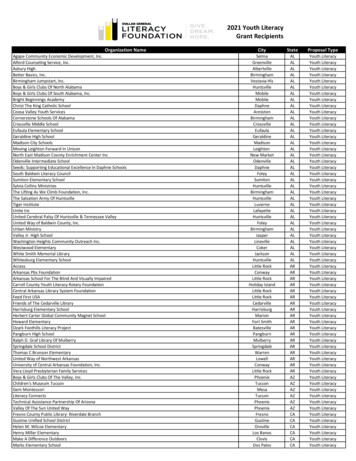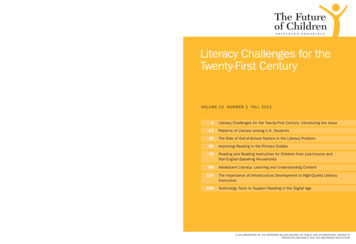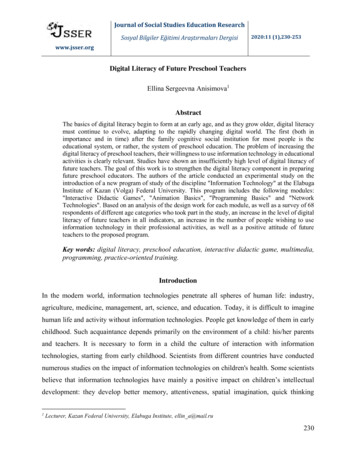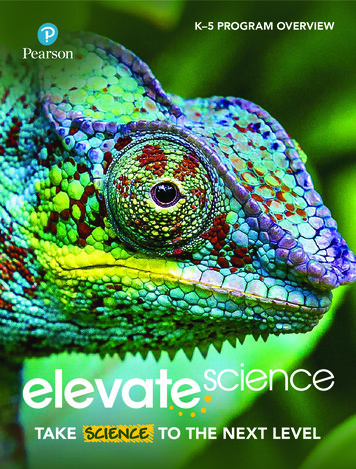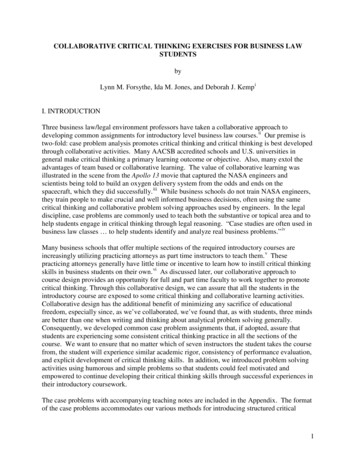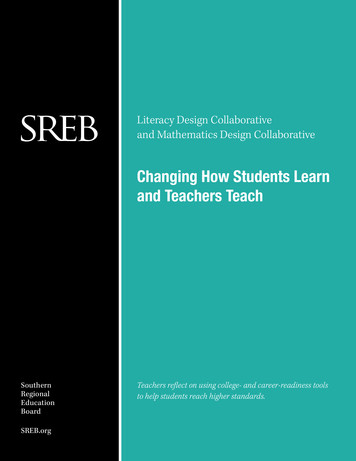
Transcription
Literacy Design Collaborativeand Mathematics Design CollaborativeChanging How Students Learnand Teachers s reflect on using college- and career-readiness toolsto help students reach higher standards.
The Southern Regional Education Board’sLiteracy Design Collaborative and Mathematics Design Collaborativeimplementation efforts are led by Senior Vice President Gene Bottoms,Lead Literacy Consultant Carol Ann Duke, andLDC-MDC Manager Dan Mollette.Contact Gene.Bottoms@SREB.orgor (404) 875-9211 for additional information.The Southern Regional Education Board works with member statesto help leaders in education and government advance education andimprove the social and economic life of the region. Based in Atlanta,SREB was created in 1948 by Southern governors and legislatures.More at SREB.org
InsidePowerful Teaching Tools, Innovative Professional Development.2Vocabulary: Frequently Used Terms .4Vignettes: Literacy Design Collaborative .5Vignettes: Mathematics Design Collaborative .27
Powerful Teaching Tools, Innovative Professional DevelopmentThis publication presents teachers’ reflections on theirearly experiences using Literacy Design Collaborative andMathematics Design Collaborative tools in their classrooms.In these vignettes they share doubts, challenges andrevelations about their teaching styles — and amazementat how much their students learn when they are challengedwith complex assignments to reach the depth of theCommon Core State Standards.The Southern Regional Education Board (SREB) is intently focused on statewide policy and practices that willimprove reading, writing and math skills so students graduate from high school ready to succeed in college andcareers. One SREB effort is employing a new approach to professional development that is bringing powerfulteaching and learning tools into classrooms statewide.These tools, Literacy Design Collaborative (LDC) and Mathematics Design Collaborative (MDC), help studentsreach the deep learning necessary to master the Common Core and other rigorous statewide standards for collegeand career-readiness. They give teachers frameworks to build lessons, in all disciplines, that engage students to readand interact with challenging texts. Students express their understanding in writing, struggle productively and learnmore — in essence shifting teaching so students take ownership of learning and achieve at higher levels.Groups of teachers and education experts developed the LDC and MDC frameworks, with initial funding from theBill & Melinda Gates Foundation. The educator groups are now expanding into wider networks of teachers, schoolsand districts working together to develop and share assignments and modules.Scaling Powerful Tools StatewideThe Southern Regional Education Board, with funding from the Gates Foundation, is using innovative professionaldevelopment to help states, districts and schools implement the Literacy Design Collaborative and the MathematicsDesign Collaborative tools more widely. Since fall 2011, SREB and the Arkansas Department of Education havepartnered to pilot a model to scale these strategies statewide. During the 2013-2014 school year, SREB plans to workwith at least two additional states on similar statewide rollout plans.continued.2
In Arkansas, SREB has worked intensively in 48 high schools — and laid the foundation for adoption in more than300 high schools by preparing certified trainer-coaches (more than 30 for LDC and 25 for MDC) at the regional andstate levels. During 2013-2014, more than 90 additional Arkansas schools will join the effort. SREB has also workedwith 150 schools in 18 other states — in total providing training, coaching and in-school support to 1,500 educatorsin 19 states over 18 months. These lead teachers then introduced the tools to several thousand teachers in theirhome schools and districts, building capacity for in-school professional development through professional learningcommunities.SREB’s intentional process for professional development builds capacity for continuous, ongoing professionaldevelopment into the school day. First, principals select outstanding teachers as lead facilitators for their discipline— language arts, science, social studies, career/tech and math. SREB trainers provide them with eight days ofintensive, off-site training over several months. Then, as the teachers work through their first assignments with LDCor MDC tools, coaches provide in-school, hands-on support, feedback on instructional strategies, and advice onliteracy modules, for example, or the appropriate place in a math curriculum for formative assessment lessons.Once lead teacher-facilitators have mastered the tools, a school’s principal establishes professional learningcommunities for each discipline, and the lead facilitator introduces other teachers in the department to theframework. The lead recruits buddy teachers from those most interested in bringing LDC or MDC into theirclassrooms and works closely with them as they learn. SREB provides ongoing webinar support for principals andteacher teams. The process engages school principals throughout so they can support teachers in a schoolwideadoption.Summer Conferences for Deep DivesThe LDC and MDC frameworks were a focus of introductory and deep-dive sessions at SREB’s 2012 High SchoolsThat Work Staff Development Conference, which was attended by 5,000 educators from around the country. In2013, SREB organized the Common Core State Standards Networking Conference, in partnership with the GatesFoundation, for teachers and school leaders to learn from experts on these literacy and math tools and from oneanother so they can help students reach college- and career-readiness.Vignettes as Early EvidenceIn these interviews, conducted by SREB trainers and consultants between September 2012 and January 2013,teachers and school leaders reflect on changes in their own behavior and in students’ motivation and engagement.As data begin to emerge, SREB shares this early evidence that, with LDC and MDC, students are learning more andperforming better on classroom and state exams.3
Frequently Used TermsCommon Core State Standards (CCSS)LDC Template TasksThe Common Core State Standards provide a clearunderstanding of what students are expected to learnand be able to do in grades K-12. They are designed to berelevant to the real world and to reflect the knowledge andskills students need to succeed in college and careers. Thestandards resulted from a state-led effort coordinated by theNational Governors Association and the Council of ChiefState School Officers.LDC contains dozens of template tasks. Template tasksare fill-in-the-blank shells that give teachers the flexibilityto insert the texts to be read, content to be addressedand writing to be produced. The result is high-qualityassignments to teach students the literacy skills they need tosucceed in education and careers.LDC Template ModuleTemplate modules add instruction to a single template task.A module is designed for approximately two to three weeks ofinstruction. An instructional ladder details what literacy skillswill be addressed, what student products will be expected,how the products will be scored, and what instructionalstrategies will be used.Lead Teacher-FacilitatorThe principal and district select 1) a teacher whom otherteachers tend to follow; 2) a teacher who has demonstratedover the years that he or she can take ordinary students andhelp them achieve at higher levels; 3) a teacher who is opento change and wants to try new approaches in the classroom;and 4) a teacher willing to make the effort to learn newapproaches and share those approaches with others.LDC Module CreatorModule Creator is an online platform teachers may use fordesigning instructional units. Module Creator supportsteacher collaboration and provides easy access to relevanttexts with a range of complex features.Professional Learning Community (PLC)and Buddy TeachersA group of teachers in a school meets periodically in aProfessional Learning Community to continuously seek andshare information and strategies to enhance their teachingeffectiveness. Lead teacher-facilitators share the tools ofLDC and MDC with members of their professional learningcommunities, recruit buddy teachers from those mostinterested, and then support them as they introduce theframeworks in their own classrooms. Eventually, with supportof the school principal, lead and buddy teachers assist allteachers in adopting these tools to help students learn moredeeply and master the Common Core State Standards.Mathematics Design Collaborative (MDC)MDC is a framework to balance instruction so that studentsdevelop understanding of basic math concepts, fluency withmath procedures, and the reasoning to know how and whento apply math knowledge and skills to solve problems. MDChelps teachers understand and implement — by designand not by chance — the Common Core or other rigorousstate standards. Formative assessment lessons, a hybrid ofassessment and instruction, are a key MDC tool.Formative Assessment Lessons (FALs)A major innovation in teaching and learning mathematics,these lessons show teachers what students understand andallow them to adjust teaching so students learn to reasonwith math and apply concepts to multi-step problems. FALsfocus on student understanding of mathematical concepts;allow students to have a productive struggle; help teachersdetermine what to change in content and instructionalstrategies so students can master the standards; and assesshow students think with mathematics.Literacy Design Collaborative (LDC)An approach for incorporating rigorous literacy standardsinto middle grades and high school content areas, LDCprovides a system for developing reading, writing andthinking skills within a variety of academic disciplines,not just in English/language arts courses. LDC tools aredesigned to help students reach the new Common Core StateStandards in literacy.4
Vignettes: Literacy Design Collaborative“My students read with a purpose My standardized test scores have improved greatly.”— social studies teacher“We learn by reading.”— chemistry student“Students are learning how to thinkand not just brush the surface of the material.”— chemistry teacher“Writing is the best way for studentsto retain knowledge.”— language arts teacher“They are working and their minds are goinga hundred miles an hour.”— assistant principal“I know that I will always use this way of learning.It has already helped me in other classes. It willhelp me get through college. It will help me in life.”— chemistry student5
Students Read With a Purpose, Teaching Is More EfficientMaria OsakweSocial Studies TeacherKendrick High School, Columbus, Georgia“With the transition from Georgia Performance Standards to Common Core State Standards, we are now requiredto concentrate more on reading informational texts, interdisciplinary/disciplinary-specific writing, and usingLiteracy Design Collaborative tasks at the end of each unit. I complete one LDC module each semester. This hasenabled my students to think critically and discuss texts we study. Usually, the task appears daunting because itis not what students are used to. This creates more work for me, but the results in the end are immeasurable. Ifacilitate their learning by guiding and prodding them to reflect on and connect with their personal experiences.“My students read with a purpose.My standardized test scores have improved greatly.”“A list of open-ended questions to spark discussions was a key strategy to get students thinking to address theprompt. Graphic organizers were useful when the students had to plan Socratic seminars or argument-baseddiscussions. The students then developed their paragraphs addressing each section of the LDC writing prompt.The detailed rubrics were useful for a checklist so students could self-assess and provide peer feedback before finalrevisions.” Throughout the semester, students were given time to compare their work in a previous LDC task withthe current unit. They wrote reflective paragraphs on the changes in their thinking process as they completed eachassignment. Most of their feedback has been increasingly positive — though, at first, the students felt the processwas too laborious.For Osakwe, the modules present a tested and proven, ready-made writing task and lesson plan strategy. It is timesaving and structured for easy implementation. Its effectiveness cannot be overemphasized. With each task, shesaid, students consistently cite evidence from the text and their research as supporting details for their opinions.“The LDC writing tasks have changed the way my students read. They read with a purpose. Rather than me having toask questions to check for understanding, my students often come up with the why and how questions for what weare reading. They question the author’s motive and style and have very strong opinions about what they read.It is time saving and structured for easy implementation.Its effectiveness cannot be overemphasized.“My standardized test scores have improved greatly. In the spring semester of 2012, I had 91 percent pass theend-of-course exam, compared to 72 percent in fall 2011 when we completed only one LDC task. LDC works forme and my students.”6
LDC Fosters Teacher Collaboration,Boosts Student Achievement in Social StudiesTimothy MorrowSocial Studies TeacherRandolph-Clay High School, Cuthbert, Georgia“My name is Tim Morrow. I teach economics, citizenship and world history at Randolph-Clay High School inCuthbert, Georgia. I (along with the other two teachers in my department) feel the Literacy Design Collaborative hasmade a positive impact in our school. It has helped with our planning. It has increased the rigor in our classroom,and it has improved student literacy skills and student writing. As far as the students are concerned, I feel thatincorporating LDC has increased students’ knowledge because it exposes them to additional sources of information;it gives them more opportunities to write; and it increases student achievement.“LDC exposes students to additional sources of information;it gives them more opportunities to write;and it increases student achievement.”“Another major benefit is that [Char-Shenda] Covington [an SREB trainer/coach] requires us to use the Good to Go toolwith a colleague in our middle grades school before we implement, submit or complete our module. This highlightsnot only our strengths and weaknesses but also those of our colleagues. The plan was well thought out, because weare collaborating with those in our building and have even gotten our administrators to give us time to plan with ourcolleagues at both the middle grades and high school levels.”“The plan was well thought out We are collaborating,and administrators gave us time to plan with colleaguesat the middle and high schools.”7
Teachers Learn to Let Students Own Their LearningCarol ParkerSocial Studies TeacherRandolph-Clay High School, Cuthbert, Georgia“I teach U.S. history and world geography. I feel that LDC has had a positive impact on our social studiesdepartment. It has helped increase the rigor in my classroom as well as my ability to facilitate instruction asopposed to simply giving in when the students struggle. Our High Schools That Work consultant provides specificfeedback for every module. She models use of strategies that address our concerns, individually and collectively.She is always optimistic even if we miss the mark.“My coach has taught me to stop hand-feeding my studentsand allow them to take ownership in the learning process.I see the changes in my teaching.”“LDC has been successful because of our ongoing observations with immediate feedback, modeling sessions andindividualized professional development. Lastly, I cannot express my gratitude in having a content specialistavailable. I see the changes in my teaching, and I am learning how to incorporate more texts, while requiringstudents to produce sustained writing. My coach has taught me to stop hand-feeding my subjects to my studentsand allow them to take ownership in the learning process.”8
LDC Helps Schools See Best Practices, Improve PlanningLeigh WilliamsSocial Studies TeacherRandolph-Clay High School, Cuthbert, Georgia“LDC has had a tremendous impact on both teaching and learning in the Randolph-Clay High School social studiesdepartment. It has allowed me to choose the best practices and instructional strategies to use with my students toincrease mastery of standards. It has helped to increase literacy skills and has added rigor to the curriculum. Witheach unit and task, I have seen students move to another level of independent learning and a change of their attitudeabout writing. Designing modules is not only an exceptional planning tool, but it also allows for reflections toimprove upon future work. It gives teachers an opportunity to figure out what is and is not working for students. It isa continuous work in progress and, although tedious initially, it has been a rewarding experience.“Designing modules is not only an exceptional planning tool,but it also allows for reflections to improve upon future work.”“Additionally, since I am department chair, implementation of LDC changed my role tremendously. I am nowresponsible for data collection, walkthroughs, etc. Not only did [Char-Shenda] Covington [an SREB trainer/coach]expose us to LDC — we also have common assessments reflective of DOK [depth of knowledge] level two throughthree questions, a standardized syllabus and departmental norms ( for all social studies classes six-12), curriculumguides and an assessment calendar.”9
Chemistry Students Learn by ReadingDoug OwensbyChemistry TeacherSpringdale High School, Springdale, ArkansasEntering Doug Owensby’s chemistry class, we know right away that this class is different from most others wehave seen. At first glance, it seems chaotic. Students entering class are each personally greeted by Owensby andbegin retrieving file folders, going to a board that is covered with materials to discuss with their writing partners,and going to their desks to begin the warm-up. Owensby seems to be everywhere. He answers questions fromindividual students. He reads samples of work that other students have done, and he encourages those who areslow to start work.Owensby is part of a group of three teachers at Springdale High School who began working with the Literacy DesignCollaborative in the summer. The teachers learned how to create modules and how to transform their teachingthrough literacy. Owensby is an exceptional teacher who has changed his methods to help his students succeed.He cares about each of his students and will do “whatever it takes,” he says, to ensure their success.“We learn by reading.”“We not only get the textbook version — we read things thatare more current, with the latest information.”Despite the apparent controlled chaos, this is a class where learning happens, where every student is valued as anindividual, and where respect flows both ways between student and teacher. The assignment of the day is to completethe culminating writing product of the module the students have been working on for the last three weeks. Studentsask questions about the many text examples on the board. They move to work with their writing partners to help eachother with this draft. Student conversations around the class are about chemistry and writing. They are writing aboutthe importance and negative aspects of plastics. They go to the side board to write the chemical formulas they needto write their papers. They work together to decide on the chemistry and discuss as scientists what would happen ifchanges were made. They direct their own learning at this point. Owensby is there as support, working with teams,working with individuals, asking probing questions, pushing his students and demanding more.Owensby’s classes are full of students at all levels. Many are second-language learners who speak about chemistryin both English and Spanish. One team of two students with English-language difficulty spoke about how they wereable to learn chemistry. “We learn by reading. We read stuff we don’t get in our books,” one girl said.continued.10
Owensby uses the textbook as a starting place for his lessons. Then he finds current scientific articles that makethe learning relevant and interesting to students. “I was worried at first about getting everything done,” he said.“But then I realized I could teach so much more through these modules, and my students learned so much more.Look at their writing,” he said. “You don’t see that kind of writing and insight in other classes.”“Students are learning how to think andnot just brush the surface of material.”His students agree. “We research, learn important things, think about what we read and base our ideas on our reading,”said Hallie, a student just finishing her writing assignment. “We not only get the textbook version — we read thingsthat are more current, with the latest information. I know that I will always use this way of learning. It has alreadyhelped me in other classes. It will help me get through college. It will help me in life,” she added.The LDC work at Springdale High School could not occur without the support of Principal Pete Joenks. Joenks fullysupports his teachers and is always looking for ways to help his students succeed. He believes in the work teachersare doing through LDC. “Students are learning how to think and not just brush the surface of material,” he said.“I know that I will always use this way of learning.It has already helped me in other classes. It will help meget through college. It will help me in life.”11
Students in All Subjects Benefit from Literacy AssignmentsChristopher JacksonEnglish/Language Arts TeacherEddy Middle School, Columbus, Georgia“I am very thrilled to be a part of the Literacy Design Collaborative. This method of instruction allows me to planlessons that guide my students to write their understanding of text they read. I have always used writing as a toolto show depth of knowledge of a passage or short story. The data I obtain from weekly writing are critical to thesuccess of my students. I can see the gaps to be filled from week to week. I address those with differentiated writingassignments for each individual student.“Writing is the best way for students to retain knowledge.”“Writing the task gives the student a guide on what is expected for each lesson. Writing is the best way forstudents to retain knowledge because this allows them to use vocabulary words from the standard and specializedterminology from that particular subject.”Jackson said he is looking forward to this year’s state assessment results, because he believes using the strategieswill make a difference. “As chair of the ELA department, I have a clear way to ensure that teachers are providingrigorous lessons reflecting increased student engagement through use of complex texts to produce sustainedwriting.”“I can see the gaps to be filled from week to week.I address those with differentiated writing assignments.”12
Social Studies Teacher Sees Value of LiteracyEric MosleySocial Studies TeacherGreenville High School, Greenville, Georgia“I’m gaining a better understanding about my students’ strengths and weaknesses. The more the students arereading and writing, the more I am able to see the importance of literacy,” said Greenville High School social studiesteacher Eric Mosley.He noted that students are reading more outside of class and bringing in research materials that they find ontheir own. Their willingness to read outside the classroom has increased, along with their interest in readinginformational, non-fiction texts as well as the fiction that young people usually prefer reading.“Students are reading more closely. They see moreconnections between what they read, what they write,and what the test is asking of them.”“Once I can identify the issue, I can address it. These issues have ranged from not clearly understanding specificvocabulary to questioning the facts presented in the reading. To see students questioning the validity of a source orthe facts involved in a reading assignment is amazing. I know they are really retaining what they are reading.“I am really enjoying asking loftier questions and receiving the students’ responses, knowing they are thinkingabout things the first time, and that they are curious. I’m having more rewarding conversations with the students.They are making connections between big ideas that they have previously studied, and they are starting to questionhow major concepts influence other major concepts. Students are also asking more complex questions of eachother and of me. Our classroom discussions are much richer and more complex.”Mosley said his students also got a 94.9 percent overall passing score on the Georgia writing assessment. “Thisscore can, at least in part, be attributed to the Literacy Design Collaborative work done in our classrooms,” he said.Students are more engaged in what they are writing because of the LDC tools that require students to apply whatthey are reading when they answer questions on tests.“Students are reading more closely when we prepare for tests and assessments. I think LDC has been part of this,because through LDC, students see more connections between what they read, what they write, and what the test orassessment is asking of them.”13
History Students Rise to the LDC Task asTeacher Begins Implementing ModulesRegina CooperSocial Studies TeacherFestus High School, Festus, Missouri“There is greater understanding by students of what is expected on an assignment. They articulate any questionsthey have more clearly, and they are much more conscientious (taking their time, asking for work to be proofread,peer editing and correcting) about the quality of work they are submitting. They are also more receptive to redoingthat work if it doesn’t meet the standard. There is somewhat less grumbling about having to read more difficult textsand having to write, as both are incorporated into every lesson.“We should not look to the language arts teachersto teach those skills. We should be doing that.”“In a two-day workshop, I was introduced to LDC at the Southern Regional Education Board Quality TeachingConference in February 2012. I was unsure what to expect, but what was presented made so much sense.Teaching literacy should not stop at the language arts classroom door. Reading a novel involves a different skill setthan reading a U.S. Supreme Court decision, or a chemistry problem or a technical manual. We should not look tothe language arts teachers to teach those skills; we should be doing that. I decided after that workshop to see how Icould implement at least some of the ideas into my classroom right away, and I have continued this year.“I have been incorporating some of the LDC methods into my daily practice, as well as more varied readingstrategies and differentiated assignments to accommodate all levels of learners. I have found the strategies lessuseful for Advanced Placement classes than for regular classes and lower-performing students.“All of the assignments are developed as a way of building onto the content of future learning, and LDC methodshave made this easier to accomplish. For instance, an informative essay on the printing revolution’s impact on theProtestant Reformation directly connects to the development of freedom of expression in American and Europeansocieties. Later on, an LDC argumentative essay on the influence of the enlightenment and Reformation on liberalpolitical thought will complement the earlier essay. Assignments also reflect more real-world tasks; reports, letters,brochures, first-person accounts, summaries and essays have all been assigned this semester. These allow thestudent to work on inference, summarizing and interpreting data instead of simply memorizing facts.”“I see myself slowly shifting from a ‘content-first’ teacher to a ‘skills-first’ teacher, where content is incorporated intothe literacy skill, instead of the skill being thrown in with the content. This helps students understand that theseskills are universal, are used in all subject areas, and will transition into the real world of the 21st-century workplace.It also helps to answer that age-old question, ‘What will I ever use history for?’continued.14
“I see myself shifting from ‘content-first’to ‘skills-first’ teacher. Content is incorporatedinto the literacy skill insteadof skill being thrown in with content.”“I brought back what I learned at the SREB Quality Teaching Conference in February to share with my literacy teammembers. Two of those members attended the half-day sessions at the High Schools That Work (HSTW) SummerConference in July.We were able to develop a 30-minute introduction of the initiative for high school faculty at the first professionaldevelopment day in late August. There were lots of questions and concerns regarding how to implement this intowhat teachers already do. Our faculty has been asked to take on a lot during the past four years under HSTW and‘one more thing’ was not really well received at first. The core area teachers were especially concerned with how touse LDC when they will have their own standards within a few years. The district has only recently begun stressingthe Common Core State Standards, and that lack of communication, combined with the mixed reviews of CCSS inthe media, are the biggest challenges regarding faculty buy-in to the initiative.“We assured the faculty they would have plenty of training and
teaching and learning tools into classrooms statewide. Th ese tools, Literacy Design Collaborative (LDC) and Mathematics Design Collaborative (MDC), help students reach the deep learning necessary to master the Common Core and other rigorous statewide standards for college- and career-readiness.
